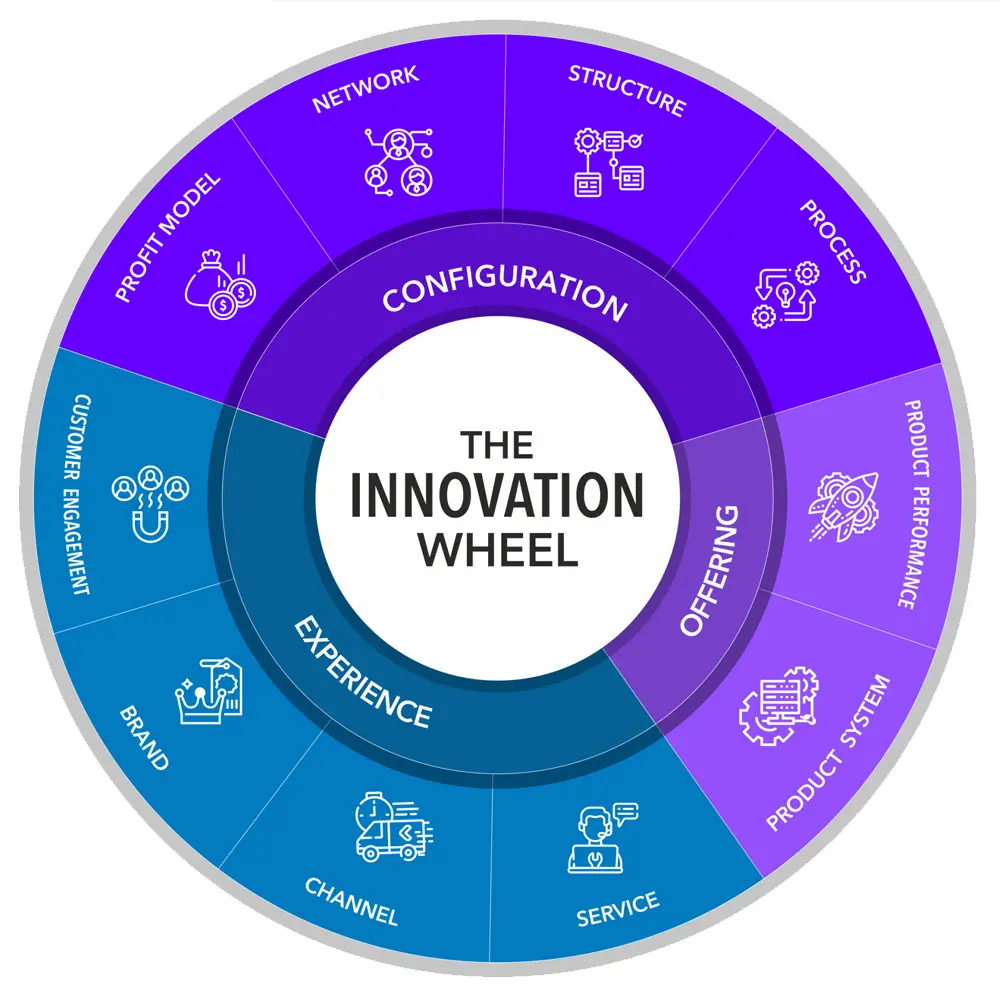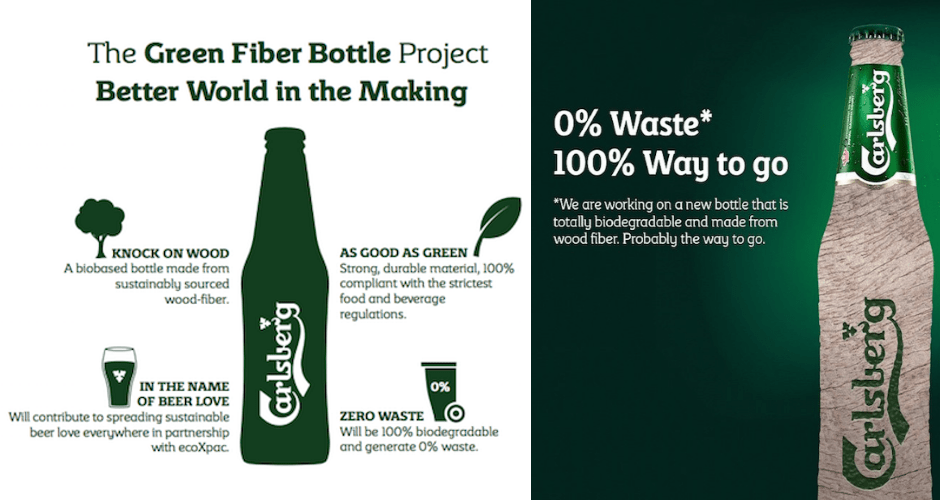Brand Innovation: Critical Steps To Follow and Why Brands Need to Grow
It is more important than ever that businesses continue to innovate their brands to set them apart in a constantly evolving and fiercely competitive marketplace. Brands that choose not to innovate may get lost in the noise and be more prone to failure.
By consistently coming up with new products and services, improving existing ones, and embracing new technologies wherever possible, businesses can maintain a competitive edge and become leaders in their industry regarding innovation.
Aside from consistently launching new products and services and using new technologies, there are many things companies can do to innovate their brands. This article will discuss brand innovation, its importance, and how businesses can utilise it to stimulate growth and long-term success.
Table of Contents
What is Brand Innovation?

Brand innovation is a process that businesses go through to improve or refresh their brand’s image and reputation and to reassert their brand’s value to consumers. By creating and implementing new and creative marketing strategies, identifying opportunities in new markets, and developing unique and captivating brand equity, businesses can set themselves apart from the competition, expand into new markets, and stay relevant to current events and popular culture.
There are many ways that businesses can work to innovate their brand. You can develop new products and services, adopt new technologies, redesign brand elements like packaging and logos, improve customer experience, refine marketing strategies, and reposition the brand to attract new customers.
By improving and refreshing a brand’s image through brand innovation, businesses can create a stronger, more resilient brand that engages customers and maintains relevance in a constantly evolving and competitive marketplace. Brand innovation can help to increase customer loyalty, expand market share, and work to stimulate healthy growth and profitability.
The types of brand innovation
A business may want to consider eight main types of innovation when creating ideas around how they plan to refresh their image and promote growth. Some innovative ideas may be evident to customers and directly impact their interactions with the brand. Some may occur behind the scenes and affect things like the structure or operations of a business.
Even the behind-the-scenes changes made to innovate a company and its brand can affect the customer experience and how they perceive the brand.
Here is a breakdown of the eight most common types of innovation that can help brands refresh their images and promote growth through brand innovation.
1 – Product innovation

Product innovation is one of the most common ways businesses can refresh their image, expand into new markets, and encourage growth and profitability. Product innovation involves developing and introducing new products into new and existing markets or improving current products.
Whether it is a new product or an improved existing one, the main goals of product innovation include the following:
- Meeting customer needs or addressing customer complaints about existing products
- Improving competitiveness
- Increasing sales and profits
Through product innovation, a business can create and implement new ideas, concepts, designs, and technology to enhance product features, functions, and overall performance. Product innovation can help a business separate itself from the competition by offering more appealing products to customers.
2 – Service innovation
Service innovation involves developing and implementing new or improved services that meet the needs and preferences of customers and the requirements of current market conditions and regulatory bodies. Service innovation could include changes in how services are rendered, changes in the technology used to provide the services or changes in the pricing model.
Many times, service innovation is something that businesses are forced to undergo due to changes in customer demand or the competitive landscape, technological advances, or shifts in regulatory conditions. Also, service innovation can occur due to unforeseen circumstances like enormous geopolitical and economic shifts. For example, the COVID-19 pandemic and lockdowns dramatically changed how many businesses render their services.
3 – Process innovation
Although process innovation may be considered more of a behind-the-scenes type, it can still directly impact a business’s customer base. Process innovation involves developing and implementing new or improved methods, technologies, tools, and procedures to improve how a business functions. Process innovation can help create new ways to streamline processes, increase efficiency, improve quality, and reduce costs.
A company that can streamline its processes and increase efficiency while improving the quality of its products and services and reducing costs can stay competitive by delivering its offerings to customers more quickly and at a better price than its competitors.
Another critical benefit of process innovation is that it can also improve overall customer satisfaction. A business focusing on customer experience and satisfaction can turn customers into loyal brand advocates.
4 – Technological innovation

Technological innovation involves using new and improved technologies to enhance existing products, create and introduce new ones, and address customers’ needs more effectively and efficiently. Additionally, technological innovation may solve problems that existed in the past that are no longer a problem.
Technological innovation combines science, engineering, design, and sound business experience to understand how to use new and emerging technologies to address customer needs and market trends. This kind of innovation could come from the emergence of new software, new hardware devices, or the introduction of new materials and manufacturing processes.
Technological innovation can not only have a profound impact on a company’s products and services, but it can also have a long-lasting impact on society by creating new industries and jobs and new ways for people to live and work.
5 – Business model innovation
Business model innovation involves creating and implementing new ways for a business to generate revenue, develop and deliver value to its customers, and manage its resources. Business model innovation typically involves:
- Leveraging new technologies.
- Shifts in customer preferences and behaviours.
- Changing market conditions to create and capture value to stay competitive and thrive.
6 – Marketing innovation

Marketing innovation is one of the most critical and visible forms of innovation a business can use to refresh its brand and attract new customers. Marketing innovation involves developing and implementing new and unique marketing strategies and techniques to promote and sell products and services. Marketing innovation requires that a business find new and effective ways to engage its customers, increase brand awareness, and create demand for its offerings.
Successful marketing innovation requires that a company has a deep understanding of the needs and preferences of its customers while at the same time being able to anticipate and react to changes in market conditions.
Marketing innovation could involve something as basic as redesigning a brand’s logo to something more involved, like introducing influencer marketing or creating an immersive and interactive brand experience through digital marketing and social media.
7 – Architectural innovation
Of all the types of innovation that a business may consider, architectural innovation is most likely to be the least visible. Architectural innovation works to improve core business systems such as accounting, manufacturing, IT, inventory management, and logistics to make fundamental changes within an organisation to reduce costs, increase efficiency, and improve processes.
8 – Social innovation

Social innovation is an excellent way for businesses to connect with customers by developing and implementing new ideas or practices that help address some of society’s broader social challenges. Social innovation that addresses social challenges could come in the form of a new product, service, or process that hopes to create positive social change and improve the welfare of individuals and communities.
The main component of success for social innovation is when a business can focus on the needs of the individual and communities rather than only the company’s economic needs. However, it is essential to note that it does not need to be one or the other. You can have social innovation that still generates revenue and profit.
Some examples of social challenges that many companies are addressing include environmental sustainability, access to education and healthcare, poverty, inequality, and human rights.
Again, it is crucial to understand that successful brand innovation often requires a combination of various types of innovation that helps a business evolve along with its customers regarding addressing needs, catering to preferences, and solving problems.
How can a business effectively integrate different forms of innovation to enhance its brand?
Before a business can successfully and effectively integrate different innovation types to enhance its brand, it should do qualitative research. Qualitative research can come from open-ended interviews, focus groups, surveys, and questionnaires. Conducting this analysis is extremely important for companies looking to fully understand their customers and learn how they should implement innovation most effectively.
Once a business understands its customers better and has identified the most effective ways to innovate its brand, it must adequately introduce and integrate the changes or innovations to make it successful.
Here are some common ways to effectively introduce and integrate innovation into a business:
- Educated integration. Any time you introduce innovation into a business, it is almost sure that its repercussions will affect virtually every aspect of a company. Businesses are large enterprises with many moving parts that all rely on one another for success. By changing one area of the business, other areas will feel the effects. If leaders understand how proposed changes might impact other parts of the business, they can adjust the integration process accordingly to minimise potential consequences.
- Effective communication. Innovation and changes within an organisation typically require the effort of multiple individuals and departments working together. Creating open communication channels and explaining the reasons for the changes and the anticipated benefits can go a long way to ensuring the innovation implementation and integration is a success. Also, open communication channels may encourage employees to voice potential problems before they become more significant or identify creative ways to help the integration process based on their knowledge and experience.
- Live and breathe innovation as an organisation. Innovation within an organisation should be encouraged from top to bottom. Allowing employees to make suggestions and integrate some of their ideas into products, services, processes, and workflows can help a company become more successful and adopt significant changes more quickly.
- Document the innovation process. When implementing an innovation, you should properly document the entire process to keep track of time, cost, and effort. This can help you better implement future innovations by identifying improvement areas and determining the actual cost of implementation.
Again, the key to successful innovation implementation is understanding which innovations will impact your business and how your customers perceive your brand. Second, a successful innovation implementation requires an effective and well-documented integration process with open communication channels for all parties involved.
Why is Brand Innovation important?
Now that we understand all the different types of innovation that can be used for a business to innovate its brand, why is brand innovation important? Why is it critical for companies to innovate their brands, and how does brand innovation contribute to their future success?
There are five main reasons that brand innovation is essential:
- Separate yourself from the competition. Brand innovation is an excellent way for companies to create unique products, services, and experiences that can separate them from the competition. Consumers have many choices regarding how they spend their money, and with how crowded marketplaces have become in the digital age, brands need to distinguish themselves from competitors.
- Remain relevant. Brand innovation can help businesses stay relevant and adapt to consumer preferences and behaviours, market trends, economic conditions, and widespread cultural changes.
- Growth. Brand innovation is a fundamental way of stimulating growth. Launching new products and services and creating unique marketing campaigns can help a business expand its customer base and increase sales and profitability.
- Brand loyalty. A company that remains relevant while addressing the needs and preferences of its customers through innovation is more likely to acquire and maintain long-term and loyal customers who may even advocate on the brand’s behalf.
- Competitive advantage. Brand innovation can bring a competitive advantage to businesses developing new products that create customer value.
What are some things that businesses can do to innovate their brands?

There are many things that a business can do to innovate its brand. Before any innovation occurs, you must conduct a qualitative market analysis. Market research can help you better understand your customer’s needs, preferences, and behaviours and help identify areas where you can improve.
Once you better understand your customer’s needs and the marketplace you operate in, you can implement one or several new ideas to help innovate your brand.
Here are some common ways that businesses can innovate their brands:
- Rebranding. Sometimes, rebranding is precisely what a business needs to take to the next level when building brand awareness and generating sales. The rebranding process may involve a name change, a new logo design, a new colour scheme, a change in messaging, or a change in the types of products and services a business offers.
- New technology. Adopting new technology to help innovate your brand can be incredibly effective. Using AI to personalise customer experiences or allowing customers to make purchases using bitcoin are just two examples of how new technology can help innovate a brand.
- New products and services. By upgrading existing products with new technology and design features or by creating entirely new products, a business can remain on the cutting edge of its industry and, at the same time, innovate its brand. The same applies to services as well.
- Collaboration. Working with other brands to create co-branded products or services is an effective way to innovate both brands. Businesses collaborating with different companies can benefit from combining resources, expertise, and creativity to develop innovative ideas.
- Become involved in social change. Companies that collaborate with non-profits or charitable organisations that fight for social change can benefit from positive PR while helping to make a difference. By devoting a certain percentage of the profits of specific products or services to fighting climate change or ending hunger, a business can maintain a competitive advantage against competitors and attract new customers.
What are some examples of successful brand innovation?

Although many companies have used different types of innovation to innovate their brand and set it apart from their competitors, a few brands have done this better.
Here are some examples of some of the most successful uses of brand innovation:
- Netflix. Netflix has pioneered the streaming industry since it transitioned from a mail-order DVD rental service to a full-fledged streaming platform. At first, Netflix dominated the streaming marketplace with little competition. However, in recent years, the online streaming industry has transformed into a highly competitive landscape. Disney, HBO, NBC, Amazon, Hulu, and Paramount are just a few examples of the big brands that have emerged in the online streaming industry. To combat this competition, Netflix innovated its brand by investing heavily in original content. Today, Netflix is well-recognised for the quality of its original and exclusive content.
- GoPro. In the world of digital photography, GoPro was different when it came out on the market. By using innovative technology, GoPro was able to give people the ability to record their adventures and extreme sports with a shock-proof and water-proof camera that can produce high-quality video and photographs.
- Google. Over the years, Google has emerged as the world’s most-used search engine. Google was able to achieve this domination by consistently updating its algorithms and search engine technology to connect online users to the most accurate and valuable sources of information.
What are some essential steps to follow to help your brand grow?
There are many essential steps that you should follow to help your brand grow. First, you need to define your target audience, what they need, their preferences, and how you can meet and cater to those needs. Defining your brand’s target audience is critical to help you concentrate your efforts on individuals most likely to engage with your brand and purchase your products and services.
Once you have defined your target audience, then you can consider the following steps:
- Create a unique value proposition. A unique value proposition is essential to clearly inform consumers of the benefits of your products and services and set your brand apart from your competitors.
- Maintain a consistent brand identity. A successful brand should have a clear voice, visual identity, and consistent messaging across all social media platforms and marketing channels.
- Develop a robust online presence. Ensure your brand has a unique and easy-to-use website, a clear social media strategy, and all online content is SEO-optimized.
- Engage your audience. Engaging your audience is more than just creating captivating content. Engaging your audience also includes responding to customer feedback, righting wrongs, and interacting with your audience on various platforms.
- Monitor brand reputation. A successful brand establishes trust with its customer base by responding to any negative feedback promptly and doing what it takes, within reason, to satisfy customer needs.
- Adjust accordingly. Make sure you are tracking metrics and evaluating your brand strategy regularly. Feel free to test new approaches as well. By monitoring various metrics, you can identify what is effective and what is not and adjust accordingly.
Wrapping up
Brand innovation can help a brand grow by attracting new customers and retaining old ones. It can also help to increase brand awareness and set it apart from the competition, driving sales, revenue, and profitability. Growth from brand innovation can also provide expansion opportunities, improve a brand’s reputation, and attract new talent who can contribute to further development.
Whether through rebranding, implementing new technologies, or launching new products and services, businesses can refresh their images while improving customer experiences simultaneously.
